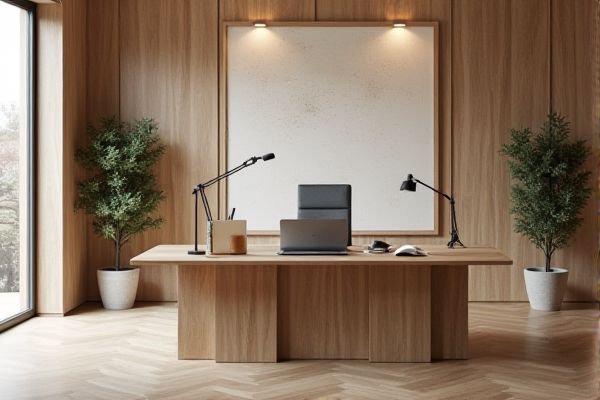
Wood veneer offers a natural, authentic appearance with unique grain patterns, while laminate provides a more durable, scratch-resistant surface ideal for heavy use. Discover which material best suits your desk needs by exploring the detailed comparison in the rest of this article.
Table of Comparison
| Feature | Wood Veneer | Laminate |
|---|---|---|
| Material | Thin layer of real wood over substrate | Layered synthetic material fused to substrate |
| Appearance | Natural wood grain and texture | Variety of colors and patterns, often mimics wood |
| Durability | Moderately durable, prone to scratches | Highly durable, scratch and stain-resistant |
| Cost | Higher cost due to real wood | Lower cost and budget-friendly |
| Maintenance | Requires polishing and careful cleaning | Easy to clean, low maintenance |
| Environmental Impact | Uses natural wood, renewable but limited | Made from synthetic materials, less eco-friendly |
| Repairability | Can be sanded and refinished | Damaged surface usually cannot be repaired |
Introduction to Wood Veneer and Laminate Desks
Wood veneer desks feature a thin layer of real wood applied over a substrate, offering authentic grain patterns and a natural appearance while maintaining affordability compared to solid wood. Laminate desks consist of a synthetic layer fused to particleboard or MDF, delivering high durability, resistance to scratches, and easy maintenance with a wide variety of color and texture options. Choosing between wood veneer and laminate depends on the desired aesthetic, budget, and performance requirements for office or home workspace furniture.
What Is Wood Veneer?
Wood veneer is a thin slice of natural hardwood, typically less than 3mm thick, applied over a core material such as plywood or MDF to create an authentic wood appearance on desk surfaces. Unlike laminate, which is a synthetic material often printed with wood-like patterns, wood veneer preserves the unique grain patterns and texture of real wood, offering a more premium and natural finish. This makes wood veneer ideal for desks that prioritize aesthetic appeal and tactile quality while maintaining cost-effectiveness compared to solid wood.
What Is Laminate?
Laminate is a durable, synthetic surface made by fusing multiple layers of resin-impregnated paper under high heat and pressure, designed to mimic the appearance of natural wood or other materials. It offers excellent resistance to scratches, stains, and heat, making it a cost-effective option for desk surfaces requiring everyday durability. Your choice between wood veneer and laminate should consider laminate's low maintenance and long-lasting finish versus the authentic look and feel of real wood.
Appearance and Design Options
Wood veneer offers a natural, authentic grain pattern that enhances the aesthetic appeal of desks, providing a warm and sophisticated look. Laminate presents a broader range of design options, including various colors, textures, and patterns, allowing for greater customization and modern styles. Your choice depends on whether you prioritize the genuine wood appearance of veneer or the versatile design flexibility of laminate.
Durability and Longevity
Wood veneer offers superior durability and longevity compared to laminate, as its real wood surface can be refinished and repaired over time, maintaining a natural aesthetic. Laminate, although resistant to scratches and stains due to its synthetic surface, tends to peel or chip with prolonged use and cannot be easily restored. Choosing wood veneer for your desk ensures a durable, long-lasting investment that retains value and beauty through years of daily wear.
Maintenance and Cleaning
Wood veneer desks require gentle cleaning using a soft cloth and mild soap to preserve their natural grain and prevent damage from excessive moisture. Laminate desks offer superior resistance to stains and scratches, allowing for easier maintenance with standard household cleaners and water without risking surface damage. Regular dusting and avoiding abrasive materials extend the lifespan of both surfaces, but wood veneer demands more cautious care to maintain its aesthetic appeal.
Environmental Impact
Wood veneer desks offer a more sustainable option due to their use of thin layers of real hardwood, reducing the demand for solid wood and minimizing deforestation. Laminate desks, often made from synthetic materials and resins, typically have a higher carbon footprint and are less biodegradable, impacting landfill waste. Choosing a wood veneer can align better with your environmental values by supporting renewable resources and lowering ecological harm.
Cost Comparison: Veneer vs Laminate
Wood veneer desks typically cost more than laminate options due to the use of real wood slices, which require skilled craftsmanship and premium materials. Laminate desks offer a budget-friendly alternative with synthetic surface layers that mimic wood grain at a fraction of the price. Your choice depends on balancing the desire for authentic wood aesthetics with the need for affordable, durable workspace solutions.
Pros and Cons of Wood Veneer Desks
Wood veneer desks offer a natural and elegant appearance with the warmth and texture of real wood, providing a more authentic look compared to laminate surfaces. They are generally more durable against scratches and heat but require careful maintenance to prevent moisture damage and warping. Your choice may depend on the desired aesthetic, budget, and willingness to invest time in upkeep, as wood veneer typically costs more and needs more care than laminate options.
Pros and Cons of Laminate Desks
Laminate desks offer exceptional durability and resistance to scratches, stains, and heat, making them ideal for heavy daily use and easy maintenance. However, laminate can chip or peel over time, and its synthetic surface lacks the natural warmth and texture found in wood veneer, which may affect aesthetic appeal. You can benefit from laminate desks if you prioritize affordability and practicality over the authentic, rich look of wood veneer.
 homyna.com
homyna.com